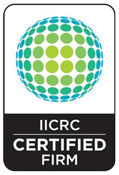What to Expect

All water damage restoration jobs are unique and the amount of work required for each depends on a variety of factors such as the amount of area in the home that’s been damaged and how long the water has been present. Once we arrive and have had a chance to inspect your intrusion, we’ll be able to put together a detailed project timeline specific to your job. In the meantime, we’ve listed the eight common phases that occur during the water damage restoration process and what happens in each, so you’ll know what to expect.
Inspection
Once our technician arrives, the first thing we will do is inspect the home and evaluate the damage. To properly evaluate the damage, we have special tools and instruments that we use to measure the moisture content of the home. To do this, we either poke or rest the instruments on top of surfaces like floors, baseboards, and ceilings in the damaged rooms to get an accurate reading. Depending on the moisture content readings and Institution of Inspection Cleaning and Restoration Certification (IICRC) dry standards for the state you live in, we will assess if drying equipment is needed.
Remove the Source
It’s time for one of the most important steps: removing the source (contaminant) from the property. The removal process is much less complicated than you may think. Our technicians will use fancy shop vacuums and rotate them around the room, sucking up all the water, soot or mold that’s present in the area. The amount of time this phase takes varies depending on the size of the room and the total amount of contamination that is present.
Drying and Dehumidifying
Once any standing water has been removed, it’s time to start drying out the home. We will bring in different types of air movers (think of these like glorified fans) to help circulate airflow throughout the room. Don’t be surprised if they need to remove the carpet, pad or both or position one of the air movers at certain sections of the walls to ensure air is getting to the most saturated parts of the room. If you have hardwood floors, we will treat them accordingly to various factors. If needed, they might even remove the baseboards and drill holes into the drywall to help the walls dry faster. While some of these methods may sound extreme, they’re making every effort to dry your property without having to demolish and rebuild, which could add multiple weeks to the project timeline and become very costly.
Prevention of Further Damage
The longer water damage sits untreated, the more likely it is that additional damage can occur. If it’s determined that drying equipment is needed, dehumidifiers will often be placed in the home to prevent against further damage like mold growth. Dehumidifiers can be present for one or multiple nights depending on factors such as the length of time the water has been present and the source of the leak. We will assess how long the dehumidifiers are needed.
Containment
The containment and drying phases happen simultaneously. While working on your property, some areas maybe taped off to concentrate contamination. Containment is critical as it enables the technicians to maintain the environment of the room and complete the work in the home or business as quickly and efficiently as possible.
Monitoring
Throughout the drying process, our team members will stop by periodically to monitor how the drying is progressing. Specifically, they monitor the dehumidifiers’ intake and output temperatures and humidity levels to make sure the dehumidifiers aren’t putting wet air out into the room. They’ll also go back and take readings of the same surfaces they did during the inspection phase. As rooms are declared dry, technicians will often move equipment around to other areas of the home that are still wet.
Completion
Once the home has been returned to its previous dry state, the water damage cleanup process is considered complete. At this point, the drying equipment will be removed from the home and we will confirm you’re satisfied with the work.
Repair of Additional Damage
After the water damage cleanup process is complete, if additional structural repairs are needed, our team will repair any damage in the home that drying wasn’t able to fully address.
Certification
EverReady Restoration is a certified IICRC (Institute of Inspection, Cleaning and Restoration Certification) Firm. The IICRC is a non-profit organization that establishes and monitors certification programs and standards for those in the industry. As a non-profit certification organization, The IICRC helps ensure that you have access to trusted and trained cleaning professionals by establishing and monitoring certification programs and standards for these industries. Our technicians are IICRC Certified in Water Restoration (WRT Certification).




